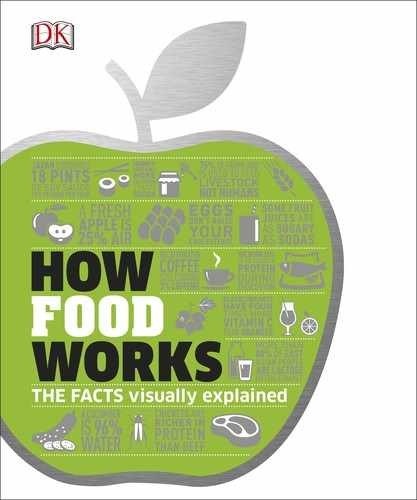
DIET
Intermittent fasting
Intermittent fasting
Fasting has traditionally been part of many religious
diets, but recently it has started to gain more interest in
scientific communities. In addition to helping with
weight loss, it is thought that intermittent fasting
has the potential to produce other health benefits.
Common fasting diets
Intermittent fasting diets involve sequenced periods of fasting and non-
fasting. In the 5:2 diet, dieters eat normally on five days a week (feast days)
but have a much reduced calorie intake on two nonconsecutive days (fast
days). The alternate day diet involves eating whatever you like one day, then
fasting the next. Diets that involve a restricted feeding window allow you
to eat only during a set time period each day—usually of 8–12 hours.
DAY 1 DAY 2 DAY 3 DAY 4 DAY 5
DAY 6
5 : 2 DIET
ALTERNATE DAY DIET
EIGHT-HOUR DIET
FAST
6
18
20
FAST
Fasting menu
On fasting days,
calorie intake is
restricted to about
one-quarter of the
recommended daily
intake. On the right
is an example of a
daily meal schedule
of 490 calories.
BREAKFAST
90 KCAL
60 KCAL
330 KCAL
1 crispbread
Miso
soup
LUNCH
corn on the cob
Small
turkey
burger
SUPPER
No food
consumed
Food eaten in
an eight-hour
window
0
SHOULD YOU
EXERCISE ON FAST DAYS?
There is evidence to suggest
that exercising while fasting
helps the body burn more fat.
However, it makes sense
to limit yourself to moderate
forms of exercise on
fast days.
5 asparagus
1 egg
FAST
FAST
12
US_200-201_Intermittent_fasting.indd 200 18/01/2017 09:48

200
DIET
Intermittent fasting
201
Potential health benefits
There is growing evidence to support the health benefits of fasting in
animals. Positive effects on blood pressure, insulin sensitivity, and the
risk of some chronic diseases have led some scientists to believe that
fasting has the potential to produce similar health benefits in humans.
RESULTS OF
STUDIES ON ANIMALS
BENEFITS
Possibility of extreme hunger, headaches, and
tiredness on fast days
Risk of mood swings and irritability
Long-term effects not yet understood
Risk of low blood pressure on fast days may
make driving dangerous
May not suit some people’s lifestyles
Can be hard to keep it up over a long period
Some people believe that fasting can lead to
an unhealthy obsession with food
Simple rules and easy to follow
No special food or supplements are required
Possible health benefits
Offers some flexibility—you don’t need to fast
on the same days each week
Some people report increased energy
Reduced food costs
On fast days, frees up time usually spent
planning meals
DRAWBACKS
Increased insulin
sensitivity
Higher insulin sensitivity
helps the body to process
glucose in carbohydrates
more efficiently, reducing
the risk of obesity and
diabetes.
Increased cell
resistance
The heart and brain
cells in fasting mice have
become more resistant to
the damage caused by
heart attack and
stroke.
Is it good for you?
The evidence that suggests that
intermittent fasting is good for
weight loss comes mainly from
animal studies (see below). If these
results are applicable to humans,
these fasting diets could be
effective in countering obesity—
and the health benefits of that are
widely known. However, the very
few human studies on fasting have
had mixed results and we don’t yet
understand the potential negative
impacts of fasting.
Reduced
cancer risk
Fasting mice have been
found to experience
significant reductions in
cell proliferation,
considered an indicator
for cancer risk.
Fighting
cancers
When used both on
its own, and alongside
chemotherapy, fasting has
been shown to slow the
growth and spread of
some cancers
in mice.
Improved
brain health
Feeding mice a
restricted-calorie diet
has improved brain
neuron regeneration
and improved the
cognitive abilities
of older mice.
Helps brain
diseases
Fasting has been shown
to slow cognitive decline
in mice with engineered
versions of Alzheimer’s
and Parkinson’s
disease.
Lower blood
pressure
Fasting has been
shown to reduce blood
pressure in mice, and even
maintain blood pressure
levels when they were
fed a high-calorie
diet.
DAY 5
DAY 6
Feast and famine
Of the variety of fasting regimes available,
the three pictured here are among the
most popular. Fasting involves considerable
commitment, and may not suit some
lifestyles, but the degree to which people
fast varies. Some follow a 500kcal fasting
regime (see left), but others commit to
300kcal a day, or even nothing but water.
5 : 2 DIET
ALTERNATE DAY DIET
FAST
DAY 7
US_200-201_Intermittent_fasting.indd 201 18/01/2017 09:48
..................Content has been hidden....................
You can't read the all page of ebook, please click here login for view all page.
